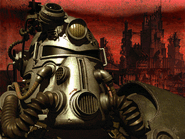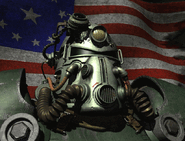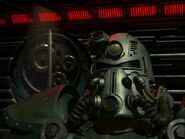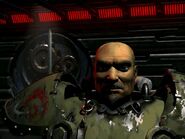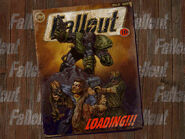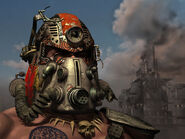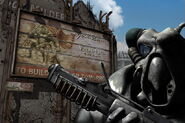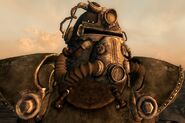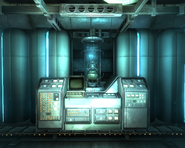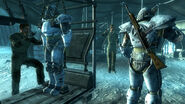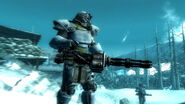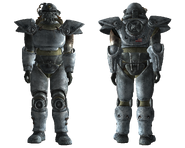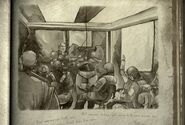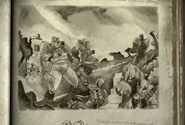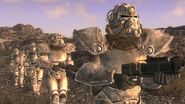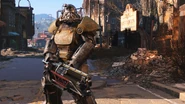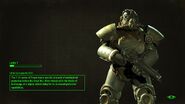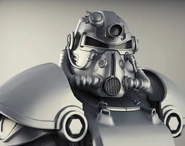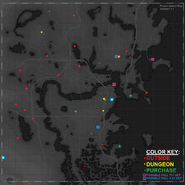| This is an overview article, listing content appearing in multiple games. |
T-51b powered infantry armor, or power armor, represented the peak of armored infantry technology before the Great War, surpassed only by its successor, the T-60 power armor. Developed in the laboratories of the West Tek Research Facility, the T51-B was deployed at the end of the Anchorage Reclamation, and by January 2077, the armor had become standard issue for American soldiers in the Army's Mechanized Cavalry Regiments. Now, only the most technologically advanced factions with ties to the pre-Great War American military or federal government, such as the Brotherhood of Steel or the Enclave, have access to this type of power armor.
Design
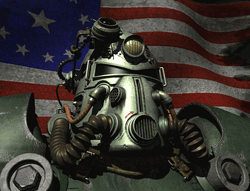
United States soldier in power armor
The armor is fitted with a back-mounted TX-28 MicroFusion Pack which generates an output power of 60,000 Watts to power the HiFlo hydraulic systems built into the frame of the suit. Made of a poly-laminate composite, the outer shell of the T-51b is lightweight and capable of absorbing over 2500 Joules of kinetic impact. The 10-micron-thick silver ablative coating can reflect laser and other radiation emissions without damaging the composite subsurface, and the eyeslit for the helmet is made of bullet proof glass to protect the wearer from any projectiles.[1] It also includes a recycling system that can convert human waste into drinkable water, enhancing survival. The armor usually carries enough fuel to last for one thousand years[verification overdue].
Post-War use
The Brotherhood of Steel does not possess the technology required to manufacture new suits of power armor and relies only on repaired and refurbished pre-Great War suits. Among the soldiers of the Enclave, this power armor is seen as obsolete, as it was replaced by the Enclave's advanced power armor and advanced power armor Mk II models, though it should be noted that it is still used by soldiers of the Enclave who have not been issued the newer armor, most likely due to slow production rates for a faction that is still quite small and possess only limited resources in the post-atomic world.
As of 2287, the T-51b seems to still be in use in the West Coast Brotherhood of Steel, while over in the East Coast Brotherhood Division, it was entirely replaced by its more advanced successor model, The T-60 armor. Additionally, after the defeat of the Enclave, the Brotherhood has the ability to manufacture more power armor, according to Paladin Danse.
History of T-51b power armor development
- August 2065: The need for increased mobility among the units of the US Army Mechanized Cavalry leads the American government's defense contractors to focus their research on the development of a man-based tank - the ultimate result is powered infantry armor.
- 2065 - 2067: Research and development into power armor intensifies among the different firms involved in the project and several prototypes are developed, many of which prove to be unworkable once they are deployed in the field. These prototypes pave the way for several major future advances in materials science, robotics, and nuclear fusion technology in the decade before the outbreak of the Great War.
- Summer 2066: The first crude nuclear microfusion cell is unveiled, one of the civilian technological spin-offs of the power armor project. The new technology is soon incorporated into a wide variety of consumer goods, including robots and automobiles. It begins to alleviate the terrible energy shortages plaguing the United States, but was unable to fully alleviate the world's energy problems before the outbreak of the Great War in 2077 made the problem moot. Ironically, had the fusion microcell technology more time to disseminate across the globe from the United States, it would have solved most of the world's energy problems, thus ending the need for the armed conflicts it was initially designed for.
- 2067: The first suit of T-45d power armor is deployed for combat duty among American infantrymen fighting the Chinese occupation of Alaska. While lacking the full mobility of future versions of the armor, this early suit of power armor is incredibly effective against conventional Chinese tanks and infantry. Its ability to allow a single infantryman to carry heavy ordnance becomes key in various localized conflicts during the Sino-American War, and it has the power to destroy entire towns without endangering the wearer from attacks by conventional firearms or even missile launchers. The Chinese People's Liberation Army rushes to create its own versions, but the Chinese are many years behind the United States' work on the project.
- 2074: Contrary to the United States' claim of waging a defensive war that seeks only to retake Alaska from the Chinese, entire mechanized infantry divisions outfitted with power armor are deployed in an American invasion of China, but they become bogged down during intense combat on the Chinese mainland, putting a further drain on American resources and supply lines in the Sino-American War.
- September 2075: Under the command of General Brock testing begins at Fort Strong, Boston on an early batch of prototype T-51b Power Armor Suits constructed by the US Army Corps of Engineers. During testing it was noticed that the test pilots were having difficulty jumping, in response to this future prototypes had a gyroscope fitted to correct the issue.
- June 2076: The T-51b power armor prototype is finally completed, resulting in the development of the suit of power armor that the Vault Dweller finds in Fallout. This suit represents the pinnacle of power armor technology before the outbreak of the Great War ends all technological progress for many decades. Many of these units are sent by the American military to the front in China, and they begin to carve a swath through the Chinese forces defending their nation, ending the stalemate that had defined the Chinese front of the war since the start of the American invasion. Chinese resources are strained to the breaking point by the new American offensive using the T-51b armor, and the supply lines from the nations China has annexed in East and Southeast Asia begin to break down.
- January 22, 2077: Power armor is used for the first time for domestic purposes within the United States by U.S. Army units deployed within American cities for crowd and quarantine control duties related to the growing resource shortages and outbreaks of epidemic disease. Units originally serving in China and on the Anchorage Front Line find themselves fighting fellow Americans at home as the disorders grow worse across the course of this year. Food riots increase, and many civilians are killed in fights with the military and police. A growing number of soldiers desert from the American military both in Canada and the United States. These deserters are captured when possible by military policemen and are sent to various military prisons across the United States. Some of these prisoners are later used by American military scientists in illegal human experiments at the Mariposa Military Base in California where the Forced Evolutionary Virus is first tested.
Appearances
T-51b power armor and its hardened version appear in both Fallout and Fallout 2 (and was to appear in Van Buren), while the latter also introduced the Enclave's advanced variants. The armor also appears in Fallout 3, where the original T-51b is unique, as the local chapter of the Brotherhood of Steel mostly wear the first successful model of power armor; the T-45d. A winterized combat version is used by American troops in Operation: Anchorage.
As shown in both Fallout and Fallout 2, T-51b models seem to exist in greater abundance along the West Coast and in New California compared to their availability in the Capital Wasteland. Even in the Pentagon, ostensibly the heart of American military power, most if not all power armor suits were of the T-45d line. While this discrepancy is unexplained, speculation suggests that T-51b units were in higher concentration in the west, possibly due to its proximity to the Chinese battlefront.
Fallout Tactics shows the T-51b power armor only once in the introduction to the game, and the Eastern Brotherhood power armor (called simply power armor there) is used instead in the game, including an advanced version, years before the development of the Enclave's new model.
In Van Buren, the appearance of the armor was slightly changed. Here's how J.E. Sawyer justified the decision:
- We tried to model the power armor as T-Ray did in the opening movie and game, but he could get away with clipping that would look really bad at close distances or certain angles. Simply put, building the Fallout power armor as it originally looked would have resulted in a suit with a tiny range of motion or a hilarious amount of clipping. We changed as much as we needed to allow for more flexibility in movement, but tried to stay very close to the original design whenever possible.
The T-51b appears in greater numbers in Fallout: New Vegas, appearing on Brotherhood of Steel patrols and sometimes appears mixed with T-45d power helmets due to a bug.
The T-51b returns in Fallout 4, and is now reliant on fusion cores for the majority of its functions, along with a functioning headlamp and multiple other modifications. T-51b and other T-51 types are commonly found throughout the Commonwealth, and provide substantial protection to the wearer.
Gallery
Fallout
Fallout 2
Fallout 3
Van Buren
Fallout Tactics
Fallout: New Vegas
Fallout 4
See also
References
| |||||||||||||||||||||||||||||||||||||||||||||||||||||||||


